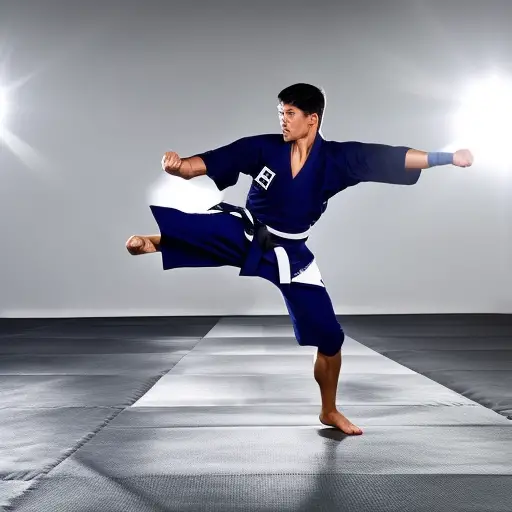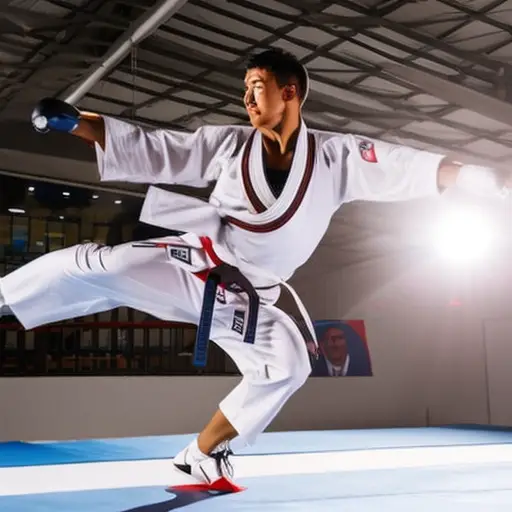Tips for Improving Taekwondo Sparring Skills

In the dynamic world of taekwondo sparring, the pursuit of excellence requires a continuous honing of skills. With a touch of irony, this article presents tips for improving taekwondo sparring skills, shedding light on fundamental techniques, speed and agility development, defensive strategies, and offensive mastery.
Moreover, it delves into the crucial aspects of mental preparation and focus, as well as training drills to enhance performance. Discover the keys to unlocking your potential in this exhilarating sport.
Fundamental Techniques for Effective Sparring
To excel in taekwondo sparring, practitioners must master and apply essential techniques to create strategic advantages over their opponents. One such technique is the art of ‘setting up’ their opponents, which involves creating opportunities to strike and counterattack effectively. This requires developing power and utilizing counterattacking techniques to gain an upper hand in the match.
Developing power is crucial in taekwondo sparring as it allows practitioners to deliver strong and impactful strikes. The key to developing power lies in proper body mechanics and technique execution. By generating power from the legs and hips, practitioners can deliver explosive kicks and punches that can potentially knock their opponents off balance or score points. Additionally, incorporating speed and precision into their strikes enhances the power behind them, making them even more effective.
Counterattacking techniques are also essential in taekwondo sparring. These techniques involve capitalizing on an opponent’s attack by swiftly countering with well-timed strikes. By observing and analyzing their opponent’s movements, practitioners can anticipate and intercept their attacks, turning defense into offense. This requires quick reflexes, awareness, and the ability to execute precise techniques.
In conclusion, mastering the art of ‘setting up’ opponents, developing power, and utilizing counterattacking techniques are fundamental to excelling in taekwondo sparring. These techniques allow practitioners to create strategic advantages and effectively score points.
In the next section, we will discuss the importance of developing speed and agility for taekwondo sparring.
Developing Speed and Agility for Taekwondo Sparring
To excel in taekwondo sparring, developing speed and agility is crucial. Footwork plays a vital role in moving swiftly and effectively during a match. By mastering proper footwork techniques, such as pivoting, shuffling, and lunging, practitioners can enhance their speed and maneuverability in the ring.
Additionally, incorporating plyometric exercises, like box jumps and ladder drills, into training routines can improve agility, explosiveness, and quick reflexes, allowing athletes to react swiftly to their opponents’ movements.
Footwork for Sparring
When it comes to enhancing taekwondo sparring skills, one crucial aspect to focus on is developing speed and agility through effective footwork. Footwork plays a significant role in sparring as it allows practitioners to move swiftly and evade their opponent’s attacks while maintaining balance and coordination.
Here are three important footwork techniques to improve speed and agility in taekwondo sparring:
-
Lateral movements: Practicing side-to-side footwork helps improve agility by allowing quick changes in direction. This technique enables fighters to dodge incoming strikes and create opportunities for counterattacks.
-
Balance: Developing strong balance is essential for maintaining stability during sparring. Proper foot placement and weight distribution enable taekwondo practitioners to move efficiently and respond swiftly to their opponent’s movements.
-
Coordination: Coordinating footwork with upper body movements is crucial in taekwondo sparring. Syncing footwork with punches, kicks, and blocks enables fighters to execute techniques with accuracy and precision.
Plyometric Exercises for Agility
Three plyometric exercises can greatly enhance speed and agility for taekwondo sparring. Plyometric training involves explosive movements that help develop power, speed, and agility.
One effective exercise is the box jump, where you jump onto a box and then immediately jump back down. This exercise strengthens your leg muscles and improves your explosiveness.
Another useful plyometric exercise is the lateral bounds, where you jump sideways as far as you can, landing on one foot and then quickly switching to the other foot. This exercise improves your lateral movement and agility.
Lastly, tuck jumps are beneficial for developing explosive power in your legs. By incorporating these plyometric exercises into your training routine, you can significantly enhance your speed and agility, improving your performance in taekwondo sparring.
Moving forward, let’s explore strategies for improving defensive skills in sparring.
Strategies for Improving Defensive Skills in Sparring
Enhance your defensive skills in sparring by implementing effective blocking techniques and precise footwork. To improve your ability to defend against attacks and react quickly, consider the following strategies:
-
Develop a strong foundation: Begin by mastering the basic blocking techniques in Taekwondo, such as high block, low block, and middle block. Practicing these techniques repeatedly will help you build muscle memory and improve your ability to block incoming strikes effectively.
-
Focus on footwork: Footwork is crucial in sparring as it allows you to create distance, evade attacks, and set up counterattacks. Work on improving your footwork by practicing various drills that involve lateral movements, pivoting, and quick direction changes. This will enhance your ability to move swiftly and maintain a strong defensive position.
-
Train for reaction time: In sparring, reacting quickly to your opponent’s attacks is vital. Incorporate reaction time drills into your training regimen, such as partner drills where your partner randomly throws strikes and you have to block or evade them swiftly. Additionally, using reaction training tools like focus mitts or agility ladders can further enhance your reaction time and defensive skills.
Mastering Offensive Techniques in Taekwondo Sparring
Mastering offensive techniques is crucial for success in taekwondo sparring.
Effective kick combinations, along with proper timing and speed, are key elements that can give a fighter an edge over their opponent.
Effective Kick Combinations
Consistently practicing and incorporating effective kick combinations is essential for achieving success in Taekwondo sparring. Mastering offensive techniques allows practitioners to effectively execute their moves and outmaneuver their opponents.
Here are three key aspects to consider when it comes to effective kick combinations in Taekwondo sparring:
-
Variety of kicks: A wide range of kicks provides versatility and unpredictability during sparring. Combining different kicks such as roundhouse kicks, side kicks, and back kicks keeps opponents on their toes and makes it harder for them to anticipate your next move.
-
Timing and speed: The timing and speed of your kicks are crucial for catching your opponent off guard. Quick and well-timed kicks can disrupt your opponent’s defense, creating openings for follow-up attacks.
-
Feints and setups: Incorporating feints and setups into your kick combinations can confuse your opponent and make them more vulnerable to your strikes. Feints involve faking a kick to deceive your opponent, while setups involve using one kick to set up another, creating a seamless flow of attacks.
Timing and Speed
With proper understanding and application of timing and speed, Taekwondo practitioners can effectively execute offensive techniques in sparring. Timing techniques refer to the ability to anticipate and react to an opponent’s movements, allowing the practitioner to strike at the most opportune moment. This requires keen observation and quick decision-making skills.
Speed training is crucial in Taekwondo sparring as it enables practitioners to execute their offensive techniques swiftly and efficiently. It involves drills and exercises that focus on enhancing reaction time, agility, and overall speed of movements.
Mental Preparation and Focus for Successful Sparring
To achieve successful sparring in Taekwondo, it is essential to cultivate mental preparation and unwavering focus. Mental focus is crucial in a sport that requires split-second decision-making and lightning-fast reactions. Here are three key techniques that can help improve mental preparation and focus for successful sparring:
-
Develop a strong mental focus: Training the mind is just as important as training the body in Taekwondo. Techniques such as meditation and mindfulness can help develop a strong mental focus, allowing you to stay present in the moment and block out distractions.
-
Utilize visualization techniques: Visualization is a powerful tool that can enhance performance in sparring. By visualizing successful techniques, strategies, and outcomes, you can train your mind to react instinctively in real-time situations. Visualizing yourself executing flawless techniques can boost your confidence and improve your overall performance.
-
Practice mental rehearsal: Mental rehearsal involves mentally going through different sparring scenarios and imagining yourself executing the perfect technique. This technique helps you prepare for various situations and allows you to strategize and plan your moves in advance. By mentally rehearsing different scenarios, you can sharpen your decision-making skills and react more effectively during sparring matches.
Training Drills to Enhance Taekwondo Sparring Performance
Implementing dynamic kicking drills can significantly enhance Taekwondo sparring performance. These drills focus on improving speed, accuracy, and power, all of which are essential for success in sparring. Training techniques that involve repetitive kicking motions can help develop muscle memory and improve technique.
One effective drill is the ‘kicking combination’ drill, where practitioners perform a series of kicks in quick succession, such as a front kick followed by a roundhouse kick and a hook kick. This drill helps improve coordination and fluidity of movement.
Another training technique that can enhance sparring performance is partner drills. These drills involve practicing offensive and defensive techniques with a partner, simulating real sparring scenarios. This allows practitioners to refine their timing, distance control, and reaction speed. Partner drills can also include specific conditioning exercises, such as practicing blocking and countering techniques while wearing weighted gear or using resistance bands. These exercises help improve strength and endurance, which are crucial for sustained performance during sparring matches.
Incorporating plyometric exercises into training routines can also be beneficial for enhancing sparring performance. Plyometrics involve explosive movements, such as jumping and bounding, which help develop power and speed. Exercises like box jumps, burpees, and explosive kicks can improve leg strength and explosiveness, allowing practitioners to generate more power in their kicks and movements.
Frequently Asked Questions
How Long Does It Take to Become Proficient in Taekwondo Sparring?
Becoming proficient in taekwondo sparring depends on various factors such as individual aptitude, dedication, and training regimen. It typically takes consistent practice, focus on improving sparring techniques, and training for taekwondo competitions to achieve proficiency.
Are There Any Specific Age Requirements for Participating in Taekwondo Sparring?
Age requirements for participating in taekwondo sparring vary depending on the individual’s physical and mental readiness. Safety regulations dictate that participants must be of a certain age to ensure their well-being during training and competition.
What Are the Most Common Mistakes Beginners Make During Sparring?
Common mistakes beginners make during sparring include lack of footwork, poor timing, and overcommitment to attacks. To improve, beginners should focus on developing proper technique, maintaining distance, and employing effective defensive strategies.
How Can I Improve My Flexibility for Better Sparring Performance?
To improve sparring performance in Taekwondo, it is essential to focus on enhancing flexibility through targeted exercises and stretching techniques. Flexibility allows for better range of motion, speed, and agility, ultimately leading to improved sparring skills.
Can Taekwondo Sparring Help With Self-Defense in Real-Life Situations?
Taekwondo sparring can indeed help with self-defense in real-life situations. By incorporating street self-defense techniques and practicing in realistic combat scenarios, practitioners can develop the skills and confidence needed to effectively defend themselves.
Conclusion
In conclusion, improving taekwondo sparring skills requires a combination of fundamental techniques, speed and agility training, defensive strategies, offensive mastery, and mental preparation.
By honing these aspects of their practice, athletes can enhance their performance in the sparring ring.
Just as a well-trained dancer effortlessly moves across the stage, taekwondo practitioners who dedicate themselves to improving their skills can achieve a similar grace and fluidity in their sparring, captivating both their opponents and the audience.





